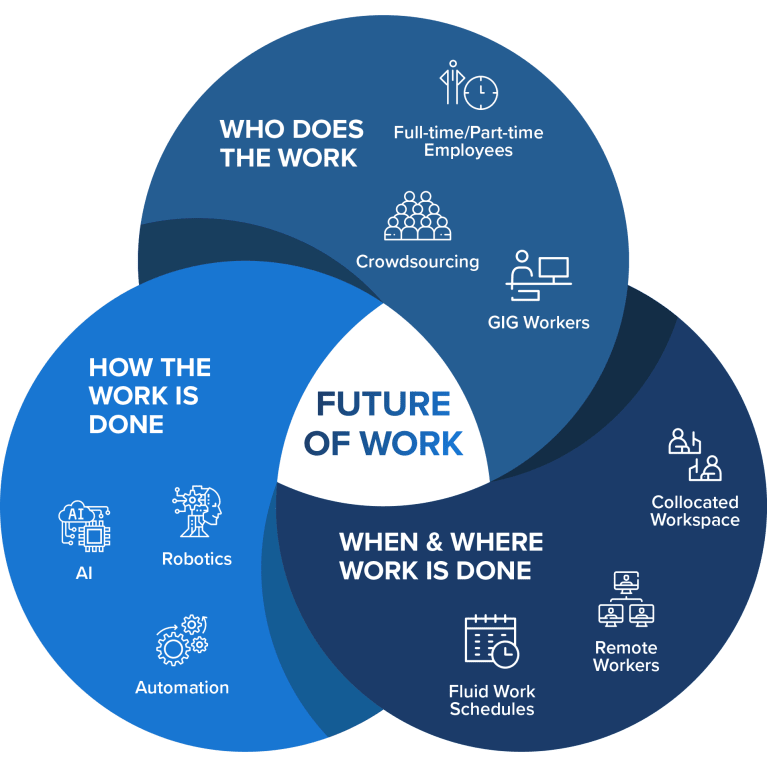The New Era of Work: Exploring the Impact of Remote Work on the Future of Workplace
Over the past decade, advancements in technology have paved the way for a significant increase in remote work. The COVID-19 pandemic further accelerated this trend, with companies worldwide forced to adapt to remote work arrangements to ensure the safety of their employees. As we look ahead, it seems likely that remote work will continue to play a significant role in the future of the workplace, enabling employees to work from anywhere and providing companies with the ability to tap into a global talent pool. However, this shift also presents challenges in terms of communication, collaboration, and maintaining a healthy work-life balance. Ultimately, the future of work is likely to be a hybrid model that incorporates both in-person and remote work arrangements, tailored to the needs and preferences of individual employees and businesses.

Remote work has become increasingly popular due to the numerous benefits it offers both employers and employees. For employers, it can significantly reduce the cost of office space and overhead expenses, as well as increase productivity and employee satisfaction. Additionally, remote work allows employers to access a global talent pool, enabling them to hire the best talent regardless of location. For employees, remote work offers greater flexibility, work-life balance, and the ability to work from anywhere, eliminating the need for long commutes and providing greater control over their schedules. However, it also presents challenges such as the need for effective communication and the potential for isolation, which employers must address to ensure their remote workforce is happy, engaged, and productive. Overall, the benefits of remote work make it an attractive option for both employers and employees, and it is likely to continue growing in popularity in the years to come.
While remote work offers many benefits, it also presents challenges that must be addressed. One of the biggest challenges is the lack of face-to-face interaction, which can lead to feelings of isolation and disconnection from colleagues. It can also be challenging to maintain work-life balance when your home becomes your office, blurring the line between work and personal life. This can result in longer work hours and difficulty disconnecting from work-related tasks. Additionally, remote workers may struggle with distractions at home, such as family members, pets, or household chores. Addressing these challenges requires effective communication, supportive management, and clear boundaries between work and personal life. By finding ways to overcome these obstacles, remote workers can enjoy the benefits of working from home while maintaining a healthy work-life balance.
As remote work becomes more prevalent, companies are finding new ways to address the challenges it presents. One approach is the hybrid model, which allows employees to work remotely some of the time and come into the office for in-person collaboration and team building. This model offers the best of both worlds, enabling employees to enjoy the flexibility of remote work while still fostering a sense of connection and community with their colleagues. Additionally, companies are investing in new tools and technologies to help remote workers feel more connected and engaged, such as video conferencing software, messaging apps, and virtual team-building activities. By adopting these approaches, companies can create a more inclusive and supportive work environment that empowers their employees to be productive and engaged, regardless of where they work from.
Virtual reality (VR) is a cutting-edge technology that is changing the face of remote work. By recreating the experience of being in the same room as colleagues, VR can help remote workers feel more connected and engaged. With VR, remote workers can attend meetings, participate in team building activities, and even work on projects together in a shared virtual space, all while feeling as if they are in the same physical location. This can help to overcome the feeling of isolation that many remote workers experience, fostering a sense of community and collaboration among team members. As VR technology continues to advance, it has the potential to revolutionize the way remote work is conducted, enabling companies to create more inclusive and connected work environments that empower their employees to be productive and engaged, regardless of their location.
Clear communication and collaboration are crucial for the success of remote teams. In order to work effectively, remote teams must establish clear communication channels, set goals and expectations, and build a culture of trust and accountability. This can be challenging, especially when team members are spread across different time zones and locations. However, with the right tools and practices, remote teams can be just as effective as in-person teams. Video conferencing, messaging apps, and project management software can help remote teams stay connected and on track. Regular check-ins and team-building activities can also help to build relationships and foster a sense of community. By prioritizing communication and collaboration, remote teams can achieve great things and drive the success of their organizations.
The future of work is undoubtedly remote, and companies that recognize and embrace this trend will be better equipped to attract and retain top talent. Although remote work presents its own set of challenges, innovative technologies and novel approaches to work can help overcome these obstacles and create a more connected and productive remote workforce. As we move into a post-pandemic world, the role of remote work will only become more critical, and companies that fail to adapt risk being left behind. By prioritizing the needs of remote workers and investing in the right tools and practices, companies can create a flexible, inclusive, and resilient work environment that empowers their employees to thrive, regardless of their location.
Image Source : SHRM






